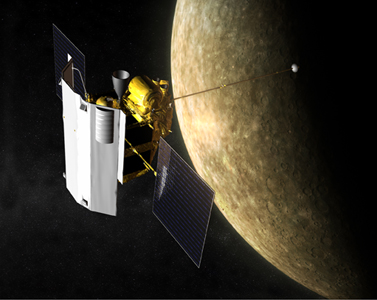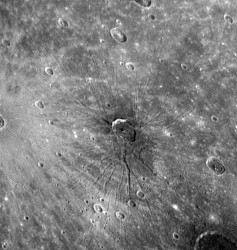Scientists from the MESSENGER mission continue to analyze the data from the spacecraft’s first flyby of Mercury on January 14, 2008. Initial data about the planet’s gravity field grabbed the science team’s attention, as the actual gravity data differed from predictions based on the Mariner 10 flyby in 1975. Any unknowns in Mercury’s gravity will provide challenges for the spacecraft’s navigation during the next flyby in October, and especially when MESSENGER goes into orbit of Mercury in 2011. This in turn could affect quality and detail of science observations. “There indeed are residuals that we have not yet been able to explain fully,” said Ralph McNutt, MESSENGER Project Scientist. “While we believe we have resolved possible extraneous effects, we continue to work those as well.”
The new data about Mercury’s internal structure is different from what the scientists expected. McNutt said that while it was surprising that the tracking data did not fit all of their preconceived notions from Mariner 10, MESSENGER went much closer to Mercury than did Mariner, which could account for the differences in data. Scientists believe there may be a large concentration of mass (mascons) under Mercury’s surface about 10 degrees south of the equator at about 60 degrees longitude. A presentation by team member David Smith at the Lunar and Planetary conference in March showed that they were able to account for about 95% of the problem deviation using a single mass anomaly at that location.
“This also leads into the most important thing on flyby 2,” said McNutt, “as we will have closest approach on the other side of the planet, we will then be able to obtain a much better separation of global versus local (mascon) signatures. So we expect major advances in our understanding of the gravity field from the 2nd flyby as it will complement the information gleaned from the first.”
From MESSENGER Navigation Team Chief Ken Williams’ perspective, any new information and understanding of this issue is important. “We’re following very closely any developments in understanding the gravity field,†said Williams. “As we encounter Mercury each time, we’re trying to build up our knowledge of what the gravity field is going to be. It’s not critical that we know it in fine detail right now, but obviously when we settle into orbit we’re going to want to know a lot more about it because that will affect the design of the orbit trim maneuvers that we’ll have to do.”
McNutt said the initial the command loads for the second flyby are being delivered to Mission Operations this week.
But Williams said the first flyby provided good news as far as knowing Mercury’s actual location in space. “While we had a pretty good idea of Mercury’s ephemeris, that fact that it hadn’t been visited by a spacecraft for a long time, there was a chance it would be different than we thought,†said Williams. “We did some things with optical navigation as we were flying by and it confirmed that it was only 2 km away at most from the ephemerides that JPL publishes. That was a great relief. That takes away the uncertainty for future encounters.â€
MESSENGER’s orbit around Mercury will be affected by another perturbation, known as third body gravity, from the Sun’s gravity field. At first this effect will draw MESSENGER away from Mercury, but later in the mission it will force the spacecraft towards the planet. Williams said one navigation analyst estimated that if the mission ended in 2012 and no further maneuvers were done by the spacecraft, MESSENGER would impact Mercury sometime in 2016.
McNutt was clearly pleased with the data from the first flyby, and looks forward to the second. “The first flyby provided humanity’s first closeup of 21% of Mercury’s surface as well as an amazing set of data on the Caloris basin. We have also made major advances in our understanding of Mercury’s exosphere, magnetosphere, and surface mineralogy. The second flyby will provide a similar close-up of another 33% of terra incognita, and only ~1% of Mercury will not have been viewed by a spacecraft when we enter orbit in 2011.”



Cool. Just goes to show that there’s no substitute for observations. Still, even after all those years, the little planet can yeid surprises.
They will be surprised to find a variable gravity and magnetic field per revolution and per orbit period. Mercury has a major liquid iron core and its inertia is the reason for the elliptic orbit (and wobble). Many circular Solar magnetic fieldlines are crossed per revolution (‘year’) affecting the induced flux of the planet. Messenger will crash or fly past when trying to orbit.
according to the absolute physics,
the messenger will be deviated gravitatioanlly from the nasa trajectory by an electro anti gravitational effect from mercury on the messneger and the deviation is a precession for messenger perihelion almost lesser than 7 arcsecond generated from two flyby.